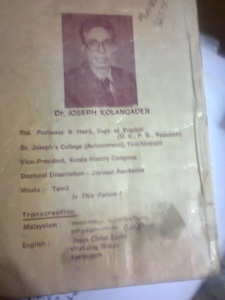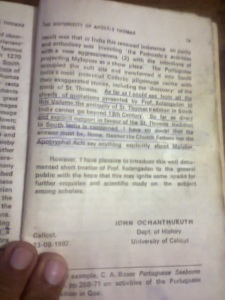Joseph Kolangaden - Vice-President Kerala History Congress, Retd HOD, English Dept, St.Joseph College, Trichy, Tamilnadu wrote a book “The Historicity of Apostle Thomas”– 1993, claiming compiling of evidence in small book.


His back ground in the rear cover says he has published books in Tamil.
Heading – Corroboration from Early Tamil Literature.
 |
//Bardaisson
was associated with
‘Elagabolus’
the author of ‘Chilappadikaram’. Bardaisson
himself
migh be ‘Madurai Koola
Vankan
Chattanar’ – the royal trade
commissioner.
//page -31
//’Manimekhalai’ celebrating the
courtesan’s daughter turned ascetic,
inculcates the diametrically opposite
approach to sex, in fact the Manichaean
attitude to sex.// page- 31//
|
 |
//Any way Manimekhalai Gathai 27
describes
the ‘Isanuvadigal ‘ of
Vanchimanagar
with strict monotheism,
most
likely a reference to the nascent
Christian
community.// Page -32. Let us Manimekhalai below.
|
|
iRaivan Eesan ena
ninRa
Saivavaathi neerpaduthalum
The Saivaite says Lord Siva is my God. (Siva is mentioned
as Easan my God)
This verse proves Christians in Tamilnadu for this
Professor.
|
Dr.Joseph Kolangaden, during this book writing
was Vice-President Kerala History Congress.
 |

//The
St.Thomas Mount ( 6 miles from Mylapore) church treasures besides the
bleeding
cross, a painting of Our Lady traditionally considered to be by the
Evangelist
St.Luke and brought by
St.Thomas.//
Page 29
The Cross
has inscriptions of 9th century in Pahalvi Language with varying readings,
and the picture is dated to 10th Century CE.
For this Professor these prove Thomas coming.
|
 |
An Appraisal from a fellow Christian Professor Mr.John
Ochanathuruth,
of
Department.
“As for as I could see from all the
Shreds of Quotations presented by
Prof. Kolangadan in this Volume,
the antiquity of St.Thomas Tradition in
|
Jesus telling himself as God- only in 4th Gospel are fictions.
Mackennal Professor of Church History at Oxford University . C. J. Cadoux’writes : “The speeches in the Fourth Gospel (even apart from the early messianic claim) are so different from those in the Syoptics, and so like the comments of the Fourth Evangelist both cannot be equally reliable as records of what Jesus said : Literary veracity in ancient times did forbid, as it does now, the assignment of fictitious speeches to historical characters: the best ancient historians made a practice of and assigning such speeches in this way.”——– 1. C.J. Cadoux: The Life of Jesus, p. 16.
Jesus never started any Religions -//All this should make clear that the view, which still persists in some circles that Jesus’s aim was to found a Church, different from Synagogue is quiet improbable. The Gospels themselves bear little trace of such a view…. Thus attempts to picture Jesus as breaking away Judaism, of Conceiving a religion in which Jews and Gentiles stood alike, equal in the sight of God, would appear to be in fragment contradiction to Probability//. page 144-45. Christian Beginnings Part- 2 by Morton Scott Enslin
Jesus never started any Religions -//All this should make clear that the view, which still persists in some circles that Jesus’s aim was to found a Church, different from Synagogue is quiet improbable. The Gospels themselves bear little trace of such a view…. Thus attempts to picture Jesus as breaking away Judaism, of Conceiving a religion in which Jews and Gentiles stood alike, equal in the sight of God, would appear to be in fragment contradiction to Probability//. page 144-45. Christian Beginnings Part- 2 by Morton Scott Enslin
“The office of Messiah-ship with which Jesus believed himself to be invested, marked him out for adistinctly national role: and accordingly we find him more or less confining his preaching and healing ministry and that of his disciples to Jewish territory, and feeling hesitant when on one occasion he was asked to heal a Gentile girl. Jesus, obvious veneration for Jerusalem, the Temple, and the Scriptures indicates the special place which he accorded to Israel in his thinking: and several features of his teaching illustrate the same attitude. Thus, in calling his hearers ‘brothers’ of another (i.e., fellow-Jews) and frequently contrasting their ways with those of the Gentiles, in defending his cure of a woman on the Sabbath with the, plea that she was a daughter of Abraham’ and befriending the tax-collector Zacchaeus because he too is a son of Abraham, and in fixing the number of his special disciples at twelve to, match the number of the tribes of Israel-in all this Jesus shows how strongly Jewish a stamp he wished to impress upon his mission.” C.J. Cadoux: p. 80-81
Why Church is spreading this Fables I quote a Church Scholars WORK which tells Truth openly- “Psychologically such a Perception is important , in that it helps to attach the involved population to a long tradition which in turn insets them with Dignity and Pride. Sociologically such a cognition defines Indian Christianity as Pre-Colonial phenomenon which is of Tremendous Existential Consequence.” – Page-40, The Christian Clergy in India, Vol.-I, T.K.Comen & Hunter.P.Malony, Sage Publications
WHO WAS APOSTLE THOMAS . //"The VERY NAME of the Apostle who is known as Thomas remains obscure. Thomas is the Greek form of the Aramaic Teoma whose Greek Translation is Didymas, meaning Twin, most probably his original name was Judas, and the Parentheses and the versional variants could have been Scribal clarification. How could an Apostle be known by an epithet or an adjective such as TWIN" - Person And Faith of Apostle Thomas in the Gospels- Dr.George Kaniarakath,CMI
Church History of Travancore by C.M.Agur, (released by the Church in commemoration of Centenary Celebrations of the Church in 1903) reprint 1990, refers to the Merchant Thomas of Cana who came in 745 AD and clearly affirms-
Long after his Death the people Canonised him and the Subsequent Generation confused St.Thomas the Armenian Merchant with St.Thomas the Apostle, who never came to Malabar. This Confusion becomes more potent when we look in to the names of the Churches said to have been founded by the Merchant Thomas are Identical with the names of the Churches attributed to St.Thomas. Page-12
Long after his Death the people Canonised him and the Subsequent Generation confused St.Thomas the Armenian Merchant with St.Thomas the Apostle, who never came to Malabar. This Confusion becomes more potent when we look in to the names of the Churches said to have been founded by the Merchant Thomas are Identical with the names of the Churches attributed to St.Thomas. Page-12



No comments:
Post a Comment